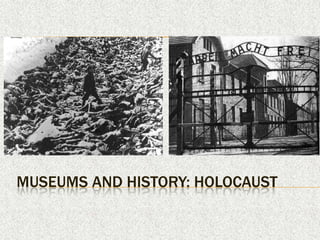
Museums and history: Auschwitz
- 1. MUSEUMS AND HISTORY: HOLOCAUST
- 2. ABOUT Auschwitz has become a symbol of terror, and the Holocaust. It was established by Germans in 1940, in the suburbs of Oswiecim, a Polish city that was annexed to the Third Reich by the Nazis. Its name was changed to Auschwitz, which also became the name of Konzentrationslager Auschwitz.
- 3. The direct reason for the establishment of the camp was the fact that mass arrests of Poles were increasing beyond the capacity of existing "local" prisons. Initially, Auschwitz was to be one more concentration camp of the type that the Nazis had been setting up since the early 1930s. It functioned in this role throughout its existence, even when, beginning in 1942, it also became the largest of the death camps.
- 4. DIVISION OF THE CAMP The first and oldest was the so-called "main camp," later also known as "Auschwitz I" (the number of prisoners fluctuated around 15,000, sometimes rising above 20,000), which was established on the grounds and in the buildings of prewar Polish barracks; The second part was the Birkenau camp (which held over 90,000 prisoners in 1944), also known as "Auschwitz II" This was the largest part of the Auschwitz complex. The Nazis began building it in 1941 on the site of the village of Brzezinka, three kilometers from Oswiecim. The Polish civilian population was evicted and their houses confiscated and demolished. The greater part of the apparatus of mass extermination was built in Birkenau and the majority of the victims were murdered here;
- 5. More than 40 sub-camps, exploiting the prisoners as slave laborers, were founded between 1942 and 1944. The largest of them was called Buna (Monowitz, with ten thousand prisoners) and was opened by the camp administration in 1942 on the grounds of the Buna-Werke synthetic rubber and fuel plant six kilometers from the Auschwitz camp. On November 1943, the Buna sub-camp became the seat of the commandant of the third part of the camp, Auschwitz III, to which some other Auschwitz sub-camps were subordinated.
- 6. INTERESSENGEBIET – THE INTEREST ZONE The Germans isolated all the camps and sub- camps from the outside world and surrounded them with barbed wire fencing. All contact with the outside world was forbidden. However, the area administered by the commandant and patrolled by the SS camp garrison went beyond the grounds enclosed by barbed wire. It included an additional area of approximately 40 square kilometers (the so-called "Interessengebiet" - the interest zone), which lay around the Auschwitz I and Auschwitz II- Birkenau camps.
- 8. INSIDE THE MUSEUM In 1979, Auschwitz was oficially recognized as a heritage of humanity by UNESCO.
- 9. GATE ENTRY “O trabalho Liberta.“ What have been left (and rebuilt) from Auschwitz turned into a museum. Each building open to the public is a living museum and has a theme. Auschwitz I came to have between 15,000 and 20,000 prisoners.
- 10. Several words from Hitler are around the museum. This is the most famous one.
- 11. JEWS’ GLASSES This is a showcase of the glasses. In the museum, giant windows were built with real objects that belonged to dead Jews, found after release and failed to be destroyed by the Germans. These objects are shown as an evidence and 5 are in the shed, where there are windows of bags, clothes, baby clothes, baby bottles, shoes for adults, children and babies, as well as brushes and so on.
- 12. Auschwitz I: playback using original clothing worn by prisoners. The photos above are some of the prisoners killed in the camp.
- 13. BRUSHES’ ROOM
- 14. ROOM BRICK
- 16. There are several photos taken in that time, showing executions in the "Block of death." Part of the field where happened the interrogations, beatings, hangings and executions. The executed were prisoners politicians Poles, leaders of the uprisings, people involved in plans to escape of the field and also those who attempted make any contact with people from off the field.
- 18. Prisoners suspected of involvement in the resistance were interrogated, beaten to death or hanged in the presence of other prisoners.
- 19. Evidence of medical experiments conducted in the field. The medicines or substances above were manufactured by Bayer. Sterilization experiments were performed on women who were permanently quarantined. Many died during the experiments and others were killed for autopsy was performed and the experiment could "evolve". Those who survived were left with irreversible defects. Other genetic experiments, as Dr. Mengele’s ones, were held in Auschwitz II and in children and cripples
- 22. The museum show jew’s quarters and writing on the walls. Rooms where more than 700 prisoners in just 30 or 40 beds. In the same place were the toilets (holes in the ground, one beside the other). The hygiene conditions contributed to the emergence and spread of disease. Soon, those who did not die of starvation, or were not performed, died of disease.
- 24. Auschwitz II In this building, known as Sauna, prisoners were registered (received their identification number that was tattooed on the inside of the forearm) and disinfected before being sent to work. Here they also received the uniform and were depilated, including women. Upon removal obviously discovered pregnant women who were immediately sent to the gas chambers.
- 26. Wall made from photos found in the luggage of prisoners after release.
- 28. Historians estimate that among the people sent to Auschwitz, at least 1,100,000 were Jews from various European countries, more than 140,000 were Poles (mostly political prisoners), approximately 20,000 Gypsies from various countries in Europe, more than 10,000 prisoners of war and Soviets more than 10,000 prisoners of other nationalities. Most Jews died upon arrival, when sent to the gas chambers. The number of victims of Auschwitz between 1940- 1945 is estimated at between 1,100,000 and 1,500,000 people.
